I've noticed over the years that this is usually misnamed in a lot of collections. Since it is the Avatar (so to speak) of the Rocky Mountain Chapter (we all know the real thing!) I thought it would be good to post this picture that really shows the distinguishing characteristics. It is widely distributed, but never common, right at treeline on the mountains visible from the Denver area: a range of maybe 150 miles: on a clear day I feel as though I could pick it out from my front door...
It isn't the smallest, showiest or rarest columbine. But it may be the cutest!

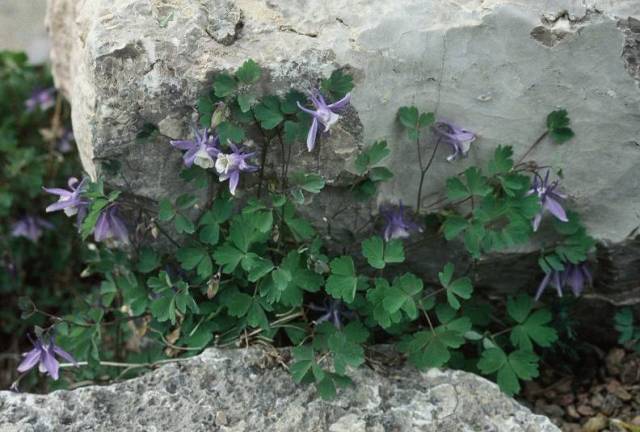
Comments
Trond Hoy
North American Columbines - starting with Aquilegia saximontana
Tue, 03/16/2010 - 2:41amI agree! What kind of rock is it? - a kind of limestone?
Richard T. Rodich
Re: Aquilegia saximontana
Tue, 03/16/2010 - 4:37pmI like columbines, but I have never been a fan in as much as to know what the features are that tend to divide species. So nothing jumps out at me as "distinguishing characteristics." Is it the plant overall, or are there particulars?
Panayoti Kelaidis
North American Columbines - starting with Aquilegia saximontana
Wed, 03/17/2010 - 6:07amFirst of all, yes! The stone is dolomitic limestone. Although in nature Aquilegia saximontana almost always grows on granite. But our granite has a lot of calcium in it. The picture was taken at Denver Botanic Gardens' rock alpine garden when I managed it (it's in very good hands now, I aver)....
Aquilegias are very distinctive in nature: species are hard to confuse with one another: our giant upfacing Colorado columbine (Aquilegia caerulea) is the parent of most of the showiest garden hybrids aside from the endless variations on the common, nodding European columbine (Aquilegia vulgaris): these aside, there are countless miniatures that are each distinct and superb. And by and large easily distinguishable: in the garden, it is true, they can hybridize and you can end up with a miserable muddle (and the occasional gem of a hybrid).
I can recognize Aquilegia saximontana instantly: the flowers are quite tiny (little more than an inch across) and always nodding on delicate stems--much smaller in bloom than many of the Eurasian "dwarfs" like Aquilegia pyreneica at one end or A. flabellata at the other end of the continent. Unlike these, A. saximontana blooms continuously (I have flowers all summer long--an endearing trait). The shape of the spurs and the way they emerge from the sepals in a distinctive shape is instantly recognizable. Columbines are the state flower of Colorado and almost sacred here...you do not dare criticize them for fear of imprisonment at the very least! They sell like hot cakes every spring at the local nurseries.
Trond Hoy
North American Columbines - starting with Aquilegia saximontana
Wed, 03/17/2010 - 2:09pmAre they as easy as other "akeleier" from seed?
Panayoti Kelaidis
Re: Aquilegia saximontana
Thu, 03/18/2010 - 6:24pmAquilegia saximontana is not only quick and easy from seed, it's long lived. I've had the same plants in a trough for ten or more years--a Methusalah for this relatively evanescent genus.l
deesen (not verified)
This was grown from Exchange
Wed, 03/26/2014 - 1:22pmLori S. (not verified)
Well, it looks pretty darn
Wed, 03/26/2014 - 5:52pmWell, it looks pretty darn convincing to me (which is to say, at least superficially*). I noticed that you also posted it at SRGC, so perhaps Bob Nold will weigh in on its identity.
*Meaning that I don't really have a clue... just that there is a general resemblance.
deesen (not verified)
Thanks for replying Lori.
Thu, 03/27/2014 - 1:38pmThanks for replying Lori. General feeling on SRGC is that my plant is Aquilegia flabellata.
Mark McDonough
Sorry, been on a week long
Thu, 03/27/2014 - 5:58pmSorry, been on a week long deadline, so missing the posts. David, I cannot say what your Aquilegia is without seeing the spurs, the spurs on saximontana are rather unique. Can you show us a photo from a side view or overhead-oblique perspecitive. I will go look on SRGC too. Most falbellata types jump out as flabellata types, this one does not jump out like that.
Lori S. (not verified)
Here's a description and
Thu, 03/27/2014 - 6:27pmHere's a description and drawing that might be helpful:
http://www.efloras.org/florataxon.aspx?flora_id=1&taxon_id=233500115
Edit: But missing the obvious... Mark made several excellent posts in the first 3 pages of this thread that discuss and show the characteristics of A. saximontana!
deesen (not verified)
Thanks Lori but I really am a
Fri, 03/28/2014 - 6:20amThanks Lori but I really am a dunce when it comes to plant ID's. Thanks also to Mark. Two further images below that I hope will be useful.
Trond Hoy
Re: Aquilegia saximontana
Fri, 03/19/2010 - 9:58amI think I will try to get hold of some plants or seed!
vanachterberg (not verified)
North American Columbines - starting with Aquilegia saximontana
Thu, 11/11/2010 - 4:14pmYes it's cute but I think Aquilegia jonesii is cuter and just as easy. I have it in a trough and it keeps seeding itself
into the surrounding gravel. I have no other aquilegias on the eastern side of the house, and since it blooms a little early
for a columbine all my seedlings seem to be pure jonesii. Maybe not quite as alpine in character as if they were growing at 8000 feet,
but very tiny, with very blue leaves and pure blue flowers. I just sent a bunch of seed to the NARGS seed exchange.
Barbara van Achterberg, Connecticut
Mark McDonough
North American Columbines - starting with Aquilegia saximontana
Thu, 11/11/2010 - 5:12pmIf it's okay, I plan on piggybacking onto this important topic, and perhaps even hijack it a bit, to enlarge the topic to North American Aquilegia, but starting most importantly with the most misidentified columbine of all time, namely A. saximontana. Panayoti's opening photo of this plant flowering at DBG shows the unique character of this delightful Colorado endemic species, dwarf but with light billowing leaflets and flowers that are instantly recognizable on account of the short spurs that ascend outwards first (divergent) and then tend to curl inwards at the apex.
I have started a lengthy posting on this very topic on the Scottish Rock Garden Forum; my inspiration: to show what A. saximontana looks like, to help mitigate the ubiquitous misidentifications, where the European A. pyrenaica or more likely the Asian A. flabellata var. pumila usurp the good name of saximontana. In the process, I'll be showing and featuring related species, photos and links to the common misnomer species, and start exploring other North American Aquilegia, I believe this continent certainly has some of the best columbines.
To kick things off, here's a little nugget I scanned, from the late Linc Foster, with an essential line drawing by Timmy Foster exemplifying the essence of Aquilegia saximontana, a dwarf open spray of leaves and flowers with those spreading or divergent spurs. This appeared in the Bulletin of the American Rock Garden Society, Vol. 38, Summer 1980, No.3, entitled "Aquilegia saximontana in Connecticut".
Mark McDonough
Re: North American Columbines - starting with Aquilegia saxi...
Thu, 11/11/2010 - 6:35pmBarbara, do you have any photos of your A. jonesii, it's fantastic that you have it growing and seeding around, I'll look for it in the NARGS seedex.
Mark McDonough
Re: North American Columbines - starting with Aquilegia saxi...
Thu, 11/11/2010 - 7:11pmShown here are several photos illustrating two different plants of A. saximontana growing in Panayoti Kelaidis' troughs. The closeup view shows the hooked spurs (uncommon for American blue species, but common enough for columbine species elsewhere in the world), the spurs splaying outwards (divergent) then curved in at the apex, the narrowish cup with diffuse color shift from blue to white or cream, and delicately flared petals at full anthesis. Notice too, the small acute leaf dentations.
Also uploaded is a fine line drawing (scanned) of this species, and A. laramiensis (endemic to Wyoming). The photos are from Gentes Herbarum, Aquilegia - The Cultivated and Wild Columbines, by Philip A. Munz, March 1946, Vol. VII, 150 pp. Something to consider about line drawings in general, they are but one point in time for one particular selected plant, and as such, are not always fully indicative of all plant characteristics nor do they represent variability encompassed by the species. Also note, both A. saximontana and laramiensis are reported to be 5-25 cm tall in the wild, so don't read more into the apparent size difference between the two plants shown in the line drawing.
Flora of North America
http://www.efloras.org/florataxon.aspx?flora_id=1&taxon_id=233500115
US Forest Service page on 5 blue columbines, starting with A. saximontana. Click each photo for an enlarged view.
http://www.fs.fed.us/wildflowers/beauty/columbines/aquilegia_saximontana...
Mark McDonough
Re: North American Columbines - starting with Aquilegia saxi...
Thu, 11/11/2010 - 7:26pmWith fair use I scanned and posted a photo of Aquilegia saximontana in Rare Plants of Colorado, Second Edition, 1997, The Colorado Native Plant Society. It's a good characteristic image, showing the divergent spurs.
Also with fair use, I scanned and posted a drawing of Aquilegia saximontana from Land Above the Trees, A Guide to American Alpine Tundra, by Anne Zwinger and Beatrice Willard, 1972. I still consider this one of the very best books on alpine plant habitats, the pages filled with charming pencil drawings that capture the essence of the subject plant, often showing the flowers and plant in various stages of articulation. Here again we see acute sepals, narrowish cup, and divergent spurs.
The 3rd fair use scan is Aquilegia saximontana from Rocky Mountain Alpines, part of Alpines '86, Second Interim International Rock Garden Conference, June 28 to July 2, 1986; Boulder, Colorado. Sorry, the scan is a bit pixelated, but the image was rather small, but you can still see the unique shape of the flower and spurs.
The last scan of Aquilegia saximontana is from a past NARGS Rock Garden Quarterly, Volume 66 Number 3 Summer 2008, the photo courtesy of Denver Botanic Garden. Here again we see the light airy foliage and flowers with divergent spurs.
Mark McDonough
Re: North American Columbines - starting with Aquilegia saxi...
Thu, 11/11/2010 - 7:45pmOther photos found of Aquilegia saximontana.
In the following link, way down near the bottom is a photo of what the grower purports to be the true A. saximontana. Translating the page with Google Translate (which does a poor job), what I can make out is that this grower tried for 10 years to get the true plant, but in the photo he shows in 2006, believes he has the true plant. I agree it looks right. To facility finding the photo easier, in fair use I uploaded a screen capture of that image (see 1st photo). Here again we see the distinctly divergent spurs, mild hook to the spurs, and acute sepals.
http://sainohana.cocolog-nifty.com/blog/2006/05/index.html
Found a second page by the same Japanese grower in 2010, can't be sure from the translation, but I believe these pictures taken 4 years later might be seedling plants, and thus subject to hybridization. Again, in fair use, I put two screen captures of the flowers side by side for comparison, showing characteristic spurs.
http://ptech.cocolog-nifty.com/blog/2010/04/post-3eb0.html
And another photo link from a different site:
http://www.picturetrail.com/sfx/album/main/153947/199482438
Mark McDonough
Re: North American Columbines - starting with Aquilegia saxi...
Thu, 11/11/2010 - 8:12pmSo, what misidentified Aquilegias go around as A. saximontana, and have done so for decades. Most often the imposter is a dwarf form the highly variable A. flabellata var. pumila (often with variable names, aka 'Nana', yezoense, akitensis, akitensis kurilensis, flabellata v. kurilensis, etc.). This Asian species has tubby rotund flowers, the sepals often incurved, having a rather different look to the flowers altogether. Other impostors include the blue European A. pyrenaica ssp. pyrenaica, or the blue and white Spanish form A. pyrenaica subsp. discolor.
To help Aquilegia fans understand key characteristics of true Aquilegia saximontana, I prepared a composite image showing 4 flowers of A. saximontana, 3 from the US Forest Service showing 3 different plants, and the 4th from Panayoti Kelaidis' plant. Key things to note: the sepals of A. saximontana are acute (rather than widely rounded as in A. flabellata pumila/nana), and at full anthesis, the sepals spread widely. The lamina ends (or "cup") of A. saximontana is narrowish, not rotund as in A. flabellata pumila/nana. The spurs on A. saximontana splay outwards (divergent) then bend inwards at the tip... the hook at the end is mild, whereas in A. f. pumila/nana the spurs are straight and parallel or angle inwards (converging) and are strongly coiled at the apices to almost 360 degrees. I also put together two detail drawings from the aforementioned Gentes Herbarum publication showing the differences in spurs; slight bend in saximontana, strong coil bend in flabellata. Not specifically described, but true in every image I've seen to date, with A. saximontana the blue color blends diffusely to the cream or white cup, whereas in A. f. pumila/nana the color change occurs with sharp demarcation.
Peter George
Re: North American Columbines - starting with Aquilegia saxi...
Fri, 11/12/2010 - 7:46amI read Barbara's short post on the ease of growing A. jonesii here in New England. I've been trying for 15 years to get one stinking bloom, and I have yet to even get one to survive more than one winter. I know that Harvey Wrightman has them blooming their little heads off after direct seeding them into a bed of tufa and crushed tufa, but so far he's the only person I know who's not growing them in the west who seems able to bloom them with regularity. Other than Barbara, of course. So if anyone out there can suggest a method for me, I'd greatly appreciate it. At this point it is the only Aquilegia I've been unable to grow successfully and flower.
Mark McDonough
Re: North American Columbines - starting with Aquilegia saxi...
Sat, 11/13/2010 - 8:42amWorth experimenting and taking the cue from Harvey, sow some seed in some of that nice tufa you have, sowing directly into some pockets drilled out and filled with some crushed tufa. Barbara said she donated seed to NARGS this year, so it'll be available. I won't get any because once again, I missed the seed donation deadline, so with seed exchange second pickings, I'm sure this treasure will be gone quickly in the first round.
I found an article about Aquilegia jonesii in an old ARGS Bulletin, I will post here as a pertinent addition to this discussion.
Mark McDonough
Re: North American Columbines - starting with Aquilegia saxi...
Sat, 11/13/2010 - 8:57amHey rock-garden-Aquilegia fans, I chanced upon the following article in the Bulletin of the American Rock garden Society, Vol.49, No.1, Winter 1991, pp 60-65, entitled Variations in Aquilegia jonesii by Jerry DeSanto. What strikes me about this article is how our notions of many plants are entrenched or locked down by a single impression, naturally Aquilegia jonesii is a deep blue-flowered species right?
This article helps illuminate some of the beautiful variability of this species. It also describes the putative hybrid A. jonesii x flavescens (with photo too) and shows a gorgeous dwarf A. flavescens form. The latter species, A. flavescens is one of the unsung gems of North American columbine; I've examined indescribably beautiful swarms growing on talus slopes in Washington State, the plants were covered with yellow to salmon colored blooms. I remember thinking, why aren't rock gardeners clamoring for this species? Often this is a taller plant, but the dwarf forms are to die for.
In fair use, I have scanned and reposted here.
Mark McDonough
Re: North American Columbines - starting with Aquilegia saxi...
Sat, 11/13/2010 - 11:01amThis post in reference to plants going around for decades as Aquilegia jonesii x saximontana, which by this point in time, are invariably hybrids between other species such as A. pyrenaica and nothing to do with the two original species.
There's an article about this hybrid cross published in the Bulletin of the American Rock Garden Society, Vol. 38, Summer 1980, N0.3, pp. 113-114, "A Dwarf Aquilegia Hybrid", by Trevor Cole, Ottawa Research Station, Agriculture Canada, Ottawa, Ontario. In the article, Trevor reports on his experience growing seed of A. jonesii which had been collected on the Big Horn Mountains. In the ensuring years growing and flowering A. jonesii, the only other columbine close by was A. saximontana, reported as 6' (2 m) away. From seed harvested off his own A. jonesii plants and sown in January 1976, about 40 seedlings were grown on. In the batch of seedlings, two different forms appeared. Most plants were typical in growth to saximontana, but 5 plants were characteristic of jonesii. Almost all plants "bloomed profusely in the summer of 1977", and "seed was collected in quite large amounts and sent to the ARGS seed exchange listed as A. jonesii x saximontan". So indeed, the cross did exist at one point in time.
Surely 33 years hence, with the genus Aquilegia's well known promiscuity, unless any of these hybrids were grown absolutely isolated, there is almost no chance that anything close to the unadulterated cross between the two species exists today. It is also important to note, that the seed that was initially distributed, was itself variable, from hybrid plants that already showed a couple different growth characteristics.
Almost everything bearing the name of this cross (and sometimes you can see it listed the other way around) look to be dwarf forms and/or hybrids of A. pyrenaica.
Mark McDonough
Re: North American Columbines - starting with Aquilegia saxi...
Tue, 11/30/2010 - 9:16pmI have the pleasure to post some beautiful photos of Aquilegia saximontana taken by Jane Hendrix, of Breckenridge, Colorado, a purveyor and wonderful photographer of North American native flora, particularly Rocky Mountain alpines. One can only imagine what it must be like to live and garden at 10,000' elevation, in such close proximity to an amazing alpine flora. Her extensive photo albums in the following link show many wonderful Rocky Mountain wildflowers and alpines. We hope to see Jane here on the NARGS Forum soon.
http://www.picturetrail.com/hendrix
It is my privilege to show these photos that capture the unique essence and characteristic of the true A. saximontana. Here again, what we see is the dwarf yet upright billowy foliage of the plant, and the small soft blue and white flared flowers with splayed (divergent) spurs.
Mark McDonough
Re: North American Columbines - starting with Aquilegia saxi...
Thu, 12/02/2010 - 6:14amFollowing up on the previous post with lovely photos of A. saximontana by Jane Hendrix, Breckenridge, Colorado, USA, Jane has given me permission to post photos of a dwarf form of Aquilegia caerulea found locally among unnamed peaks that surround her 10,000' elevation home. Rather than paraphrase Jane's description, she describes it well, so here it is:
"Every plant shown was grown from seed I collected at 11,600 feet in the boulder field on the slope of Peak 6 so they are not accidental hybrids. To be certain this dwarf form [of A. caerulea] was genetically dwarf and not environmentally dwarf, I sited the plants in rich, moist soil. They all grew lusher, fuller and taller than the ones in the wild but still would be classified as dwarf. In one photo, you can see the plant's height in relation to the red Darwin tulips (the tulips get to about 20 inches tall in my garden). The dwarf A. caerulea flowers are as large as the "regular" A. caerulea. This particular group of seeds produced light blue and white blossoms but since collecting them, I have seen similar dwarf A. caerulea in a nearby rock field with the typical, deeper blue sepals. When grown side-by-side with the common (pure) A. caerulea, they don't have a chance to hybridize because the dwarf form blooms much earlier than the other one and by the time the tall one has pollen, the little one is making seed."
Thanks Jane for allowing forumists to view this rarely seen variant of Colorado's most famous plant.
Mark McDonough
Re: North American Columbines - starting with Aquilegia saxi...
Thu, 12/02/2010 - 7:24amThis dwarf version of A. caerulea might be regarded as A. caerulea var. alpina.
Aquilegia caerulea var. alpina A. Nels. is a recognized variety, in ITIS, USDA, and in Flora of North America (FONA). The problem is USDA reports var. alpina from Wyoming and Utah (not Colorado) and FONA reports var. alpina only occurring in Wyoming. Using the USDA species distribution, it would be conceivable this variety is also found in adjacent Colorado.
http://plants.usda.gov/java/profile?symbol=AQCOA
http://www.efloras.org/florataxon.aspx?flora_id=1&taxon_id=233500096
Tip: if searching for information or photos on the Colorado Columbine, use both alternate spellings; caerulea and coerulea.
Aquilegia coerulea photos, it seems that some A. coerulea var. coerulea photos show compact plants:
http://plants.usda.gov/java/largeImage?imageID=aqco_004_ahp.jpg
http://plants.usda.gov/java/largeImage?imageID=aqco_002_ahp.jpg
http://plants.usda.gov/java/largeImage?imageID=aqcac2_001_ahp.tif
Lori S. (not verified)
Re: North American Columbines - starting with Aquilegia saxi...
Wed, 03/09/2011 - 10:40pmHere's our columbine of the mountains, Aquilegia flavescens - not so tiny as your little beauties, though! It occurs in montane woods, and into the lower alpine, where, growing amongst the rocks, it is often somewhat dwarfed.

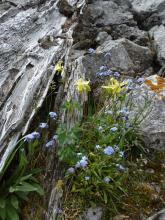
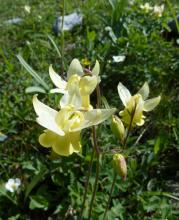
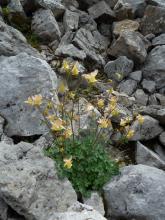

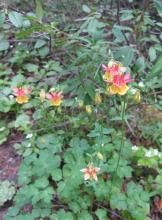
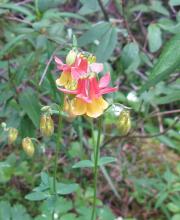
Some nice colour variations:
Richard T. Rodich
Re: North American Columbines - starting with Aquilegia saxi...
Thu, 03/10/2011 - 3:15pmI really like that flower form, Lori.
Mark McDonough
Re: North American Columbines - starting with Aquilegia saxi...
Thu, 03/10/2011 - 4:41pmThose are absolute beauties Lori! :o Years ago when scouting around the Wenatchee Mountains of Eastern Washington, I came across a talus slope covered with A. flavescens, in a form similar to the salmon-tinged ones you show as your "color variations" on the left side. It burned an indelible impression on memory; I wondered why this species is relatively ignored compared to other North American columbines. The glaucous foliage was compact, the whole plant in flower about 12-14" tall and as wide, with those really plump flowers with gracefully reflexed sepals.
It was said by a friend botanizing with me, that the salmon color forms might represent hybrids with A. formosa. The Flora of North America site reports the following: "Aquilegia flavescens sometimes forms hybrid swarms with A. formosa var. formosa , which grows at lower elevations through much of its range. Intermediate specimens having pinkish red flowers and petal blades 5-6 mm are occasionally found where these species grow together. The name A. flavescens var. miniana has sometimes been mistakenly applied to these intermediates, but the type of var. miniana is a typical, pink-sepaled plant of A. flavescens". The altitude range gets up there; 1300-3500 m.
Lori, I've never seen one quite so distinctly red and yellow like your last couple of images, true beauties they are.
The entry in Flora of North America (FNA) for A. flavescens:
http://www.efloras.org/florataxon.aspx?flora_id=1&taxon_id=233500104
...distribution map:
http://www.efloras.org/object_page.aspx?object_id=5561&flora_id=1
The USDA and ITIS also accept A. flavescens var. rubicunda from Utah, although that combination and its synonym A. rubicunda are not addressed in FNA.
http://www.itis.gov/servlet/SingleRpt/SingleRpt?search_topic=TSN&search_...
...US Forest Service page on A. flavescens and var. rubicunda
http://www.fs.fed.us/wildflowers/beauty/columbines/aquilegia_flavescens....
http://www.fs.fed.us/wildflowers/rareplants/profiles/critically_imperile...
*Footnote: FNA refers to Aquilegia chrysantha var. miniana, whereas USDA and ITIS spell it Aquilegia flavescens var. miniata A. Nels. & J.F. Macbr. Is the entry in FNA an error?
Lori S. (not verified)
Re: North American Columbines - starting with Aquilegia saxi...
Thu, 03/10/2011 - 8:30pmYes, I've often wondered about that. Flora of Alberta, in the entry for A. formosa, mentions hybrids with A. flavescens , and that A. formosa occurs at somewhat lower elevations. The range map shows A. formosa having a rather limited range, farther north than this area.
Could any of the local experts comment on the likelihood of said hybrids occurring in the mountains west of Calgary?
Trond Hoy
Re: North American Columbines - starting with Aquilegia saxi...
Fri, 03/11/2011 - 12:09amI wouldn't mind growing any of these species regardless names! I have tried some of the yellow/orange/red North American species but they haven't been the easiest to satisfy :-[ Don't know what's wrong....
Cliff Booker
Re: North American Columbines - starting with Aquilegia saxi...
Wed, 06/08/2011 - 11:45amCould someone please suggest a name for this glorious aquilegia (hybrid) seen in Ev Whittemore's beautiful garden in NC?
Lori S. (not verified)
Re: North American Columbines - starting with Aquilegia saxi...
Wed, 06/08/2011 - 12:07pmTeh long spurs suggest an A. chrysantha hybrid (assuming it is definitely a hybrid).
Cliff Booker
Re: North American Columbines - starting with Aquilegia saxi...
Wed, 06/08/2011 - 1:07pmThanks Lori ... I presumed it to be a hybrid ... I shall investigate A. chrysantha ... it could well be the species.
Much appreciated.
Lori S. (not verified)
Re: North American Columbines - starting with Aquilegia saxi...
Wed, 06/08/2011 - 8:45pmA. longissima is another possibility.
Merlin (not verified)
Re: North American Columbines - starting with Aquilegia saxi...
Sun, 04/08/2012 - 8:16pmA. longissima would be my call. i grow this species and the picture looks very similar.
Michael Peden
Re: North American Columbines - starting with Aquilegia saxi...
Mon, 04/22/2013 - 4:14amI have several Aquilegia jonesii blossoms coming on over two dozen plants. These are pretty well ahead of any other columbine in the garden. I think I'd have more fun crossing them with (the next) A. canadensis than letting them make more A. jonesii. Thoughts? Anyone in New York, Vermont, or Massachusettes have the Canada columbine in bloom and what would come of pollen (or flowers) shipped in mail? Any info on this cross?
Last year I had one late bloom on A. jonesii, the first I've ever seen (woo hoo!). I dabbed with pollen from a late flower on one of the small (European) blue ones. This either worked or the plant selfed; there were forty seeds in one pod! I scuffed them into a prepared spot and wait to see if they are good.
I do have one early bud on A. canadensis at a very warm site so I'm thinking the A gods and I might be coming into alignment. Anyway....
One final note: The oldest plant on my garden is among those coming into bloom (one big flower on a single mangy rosette). This came from seed collected in 2004. It has alternated from possibly alive to nearly dead (with obvious exception of this season). It has certainly outlived any other columbine in the garden.
Maybe I'll find a warm hillside to scour today.....
Richard T. Rodich
Re: North American Columbines - starting with Aquilegia saxi...
Mon, 04/22/2013 - 7:08amMy thought would be that a few generations of garden A. jonesii might produce a garden amenable strain for the rest of us. ;D
But a cross of anything with A. jonesii would be interesting, too.
Mark McDonough
Re: North American Columbines - starting with Aquilegia saxi...
Mon, 04/22/2013 - 10:37amJust having these plants in the garden, and growing on seedlings, one is apt to end up with hybrids, unless as Michael stated, no other Aquilegia are in bloom nearby.
I got the following plant as Aquilegia desertorum (.50 cents at a local NARGS chapter seedling sale, seed from AGS 08-09). It's a lovely plant, with foliage that looks like the right species, the flowers clearly indicate a hybrid (see link below showing the bright red conical shape of the flowers). Typically I don't opt for Aquilegia seed that has been garden collected, much rather get wild collected seed, but for half a buck, I thought I'd try it. I really like the "parsley" foliage, rather distinctive and firm to the touch, and pretty flowers on rather tall stems (2').
http://www.swflora.com/aquiligea.html
Aquilegia desertorum hybrid, flowers and foliage from 2012:


foliage now, 4-21-2013:
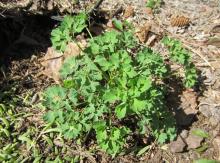
Richard T. Rodich
Re: North American Columbines - starting with Aquilegia saxi...
Mon, 04/22/2013 - 12:47pmDoes the Columbine leaf miner go after it?
They tend not to bother A. canadensis too much, but seem to like all the other (mostly non-American) species I've tried.
Mark McDonough
Re: North American Columbines - starting with Aquilegia saxi...
Mon, 04/22/2013 - 7:51pmHaven't really paid attention to the leaf-miner thing, but from the first foliage photo (2012), some leaves appear to have leaf miner damage. I'll pay more attention this year.
Michael Peden
Re: North American Columbines - starting with Aquilegia saxi...
Tue, 04/23/2013 - 11:59amThese are coming fast. It looks like the better bet might be the cross canadensis x jonesii. Cold dry sunny days and
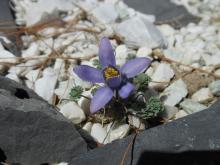
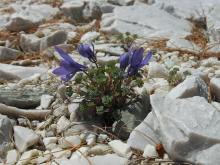

arctic nights are not speeding the A. canadensis along.
Michael Peden 4-23-13
Mark McDonough
Re: North American Columbines - starting with Aquilegia saxi...
Tue, 04/23/2013 - 3:32pmCongratulations on blooming those sweet little puppies, really tiny and beautiful.
Michael Peden
Re: North American Columbines - starting with Aquilegia saxi...
Thu, 04/25/2013 - 8:34amThanks Mark; I need to keep working.... a smattering of the pink form of Androsace carnea as well as little drabas scattered about in cheery yellow; plus I need to keep those Aquilegias going!
deesen (not verified)
I have five good seedlings in
Fri, 08/23/2013 - 12:08pmI have five good seedlings in the greenhouse from supposed Aquilegia saximontana seed from one of the UK Exchanges. I thought I might try a couple in a trough and spread the others in odd corners of the garden. I suppose they will start their dormant period soon and die down, or should I try to keep them in growth?
Richard T. Rodich
Gee, I didn't know this would
Sun, 08/25/2013 - 9:09pmGee, I didn't know this would even be a question!
I've never had any Aquilegia go dormant before the season closes, although I haven't grown many of the alpine ones.
Lori S. (not verified)
I'm curious about this too.
Sun, 08/25/2013 - 9:43pmI'm curious about this too. My large aquilegia in the border don't go dormant either. I bought a potful of A. jonesii seedlings from Beaver Creek this spring, and they are still green in the tufa bed. I also bought an unnamed alpine aquilegia from a local alpine gardener, which did either die or go dormant in early summer... I wonder which it was?
deesen (not verified)
Mmmmmm. Since the Aquilegia
Tue, 08/27/2013 - 11:18amMmmmmm. Since the Aquilegia hybrids I have in my garden eventually loose their remaining leaves when the weather turns colder I'd assumed that all Aquilegias did the same. When you use the term "before the season closes" Rick, when does this happen please?
Lori S. (not verified)
I think both Rick and I
Tue, 08/27/2013 - 11:26amI think both Rick and I thought you were referring to them going dormant during the summer, prior to the onset of killing frost...
deesen (not verified)
Sorry to cause confusion. I
Tue, 08/27/2013 - 11:38amSorry to cause confusion. I was trying to clarify whether my seedlings would go dormant naturally at the appropriate time of the year or being seedlings would they prefer to be kept in growth (in which case I would have to find alternative accommodation for them other than a cold greenhouse).
Pages